 |
| Virginie, the Fleskes, Justin and Annie an hour after we landed in CA. |
I was honored by John Fleskes to join Virginie Ropars, Annie Stegg, Justin Gerard and Dice Tsutsumi in the Flesk offices near San Francisco to pore over more than 5,500 different works of art, both for the 22nd edition of SPECTRUM, but also to annoint 5 in each group and then choose a silver and gold medal winner. It was like boiling the galaxy down into a teacup, and then giving it a medal. We as a group went through something together. We fought and joked and laughed and everything in between. Strangers by morning became friends by sunset. It was one of the most exhausting and incredible art experiences I have ever had, and I will never forget it.
But that’s not why we’re here today. Below is a list of some of what to think about, not just next time when you apply, but when you take on any image to tackle, for work or pleasure. Part of what makes all this function is that each of us in that room operate from a different vantage- we all have our preferences and our prejudices, and that’s not just okay, it’s an asset. So below is my own point of view- it’s what I look for, and doesn’t speak necessarily for the others, but something to think about for next time.
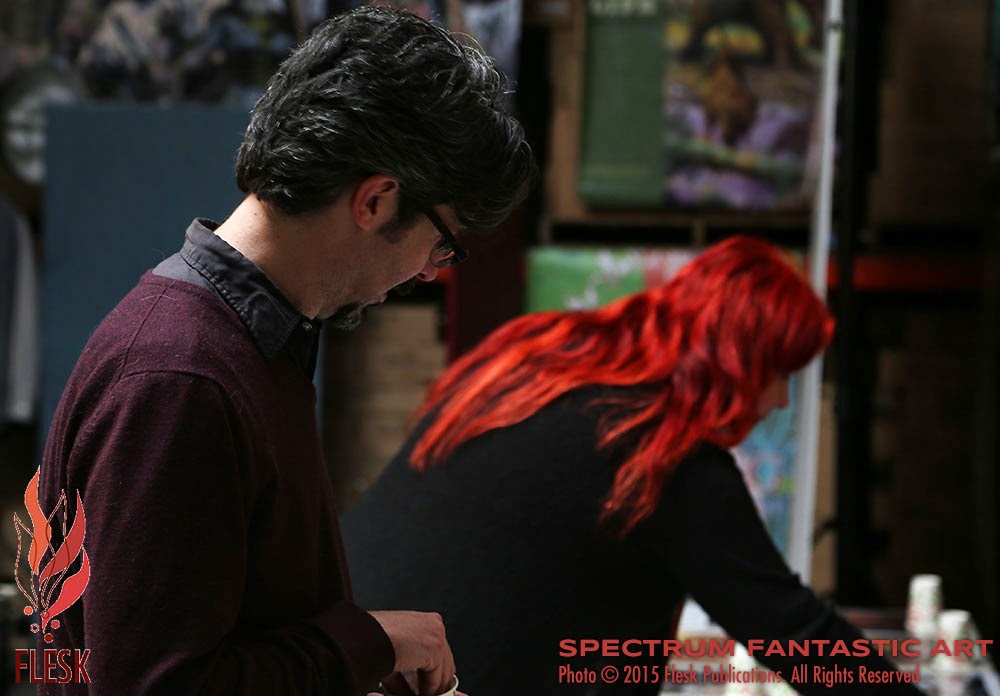 |
| Me and Virginie doing our thing with the Beans of Judgement. |
Adopting a style or genre trope, an artist’s technique or overal schtick is a completely important exercise on the road to finding your own. Sure Spectrum has its fantasy thing, and yes dragons and wizards and Tolkein themed art and leaf-faced fairies will likely always have a solid home there, but don’t think you must do these things to be there. Technically it says “Fantastic Art”, which can mean almost anything. You don’t HAVE to submit dragons, and know when you do you will be a dragon amongst a veritable swarm of dragons. Some of these will be by the masters of Dragon art and know that when poring over hundreds of them, the cream tends to jump out. Personally I recommend taking a different approach- dragons are fine, and can be awesome, but let’s see what you can do differently with them. Make it yours not theirs and it will be noticed a great deal more. My big takeaway was the breathless realization that there are thousands of people out there making work vigorously, and not all of it, for a thousand different reasons, doesn’t get careers started, or find their way into the right places. It’s not just about being loud and raising your voice above the din, but stepping out from the swarm and being seen. That’s only the first step, but it is the first step. I halted my race through the pictures for the loud and subtle pieces alike. Standing out from a crowd can simply be made possible by focusing and showing your particular vision. You all as artists have a unique way of looking at the world and I want to see that. Find your voice and sing your song. If you miss the mark you went down whole and true to yourself. If you cop someone else’s schtick and win, you didn’t win clean and it won’t feel as good. There’s no real losing if you speak with your own voice, and if you do, I guarantee you’ll get noticed.
 |
| Annie Stegg finds our sixth juror off the PCH |
To be perfectly honest, when you’re scrolling through literally thousands of pieces of art, you stop looking for what works and start looking for what doesn’t. It becomes less about plucking fruit than about clear cutting a forest. We all go in with the opposite intentions, but we turn quickly when faced with such a mountain of possibilities. You can’t ponder it all and get it done in any kind of amount of time. SO the first thing that happens is you begin skipping over like minded things more and more, (see example #1). When I land on a piece I tick through my three basic criteria, (this is just for getting into the book, mind you, not the nominations or awards- that’s a whole different bag of cats): Composition, Concept, and Craft. You hit all three of these you’re in by my reckoning. You miss one, but the other two are super strong, you could maybe still get in. You miss two- fuggitaboutit. There’s a thousand artists busting their humps to get all these three right and as I said
- COMPOSITION– Does it work as an overall form and layout? Does it surprise me with something new? Even if not, does it execute itself in a way that contributes to the work or detracts? Is the eye guided by an intended compositional structure, or is it all over the place, or unfocused? I’m all for subtle art and imagery, but if I have to ask myself what I’m looking at first thing, it’s over. Be bold and be brave and make choices. Even if they aren’t always the best or most successful ones, I will nod towards the effort.
- CONCEPT– Is the concept interesting and unique? Is it well executed and intelligent? Is there layers of depth in evidence or does it make me rethink what I may have thought going in? As I mentioned before with the dragons, you show me some kind of dragon piece that captures some perspective on these things that either celebrates their history in extraordinary ways, or makes me see them as if for the first time, you are solid. It’s a harder mountain to climb than if you took on something else not as well trod or familiar, but even so, the ability to showcase your conceptual thinking is truly essential.
- CRAFT– Is it drawn well? are the figures anatomically true, (not necessarily accurate, but true)? is the medium chosen one that exemplifies the artists’ true talents or not? These are the rocky shoals upon which a LOT of work crashed and lost out. A great composition, with an interesting concept… but then shoulder that came from the noodle world, or a face by a person that can’t really do faces… and all the air goes out. Don’t just show off what you think should be shown, but showcase what you do well and what you love, and practice. Most of the work will involve some form of figure in part or whole- please please please, get thee to a drawing class or model session and get your anatomy and figure drawing down. It not only will make your human forms more solid, but because the human figure is so difficult, it will inform your other aspects as well. I cannot stress enough how important it is to be able to craft this well. A lot of painted flourishes, or 3-d glasses won’t hide a weakness in any of the above three. Tricks like that are fun, and frankly a delight when you’re drowning in a lot of art all at once, but they don’t carry the day. (also if you submit with stereoptic or 3-d glasses as an extra bonus that’s great, but if the piece requires them to be appreciated or function basically…. not so much. Remember- Spectrum does not come with such accessories. The piece has to sing without the tech).
There’s a lot more I consider when looking at a piece, but again, with so much to see, codifying a simple checklist like this is a necessary requirement. It may mean steamrolling over pieces that have potential in other areas, or break the hearts of up and coming young artists for whom being in this book is a necessary encouragement to continue. Like I said before, judging this thing is not for the faint of heart. Hang your hat on these three poles and you’re going to be fine.
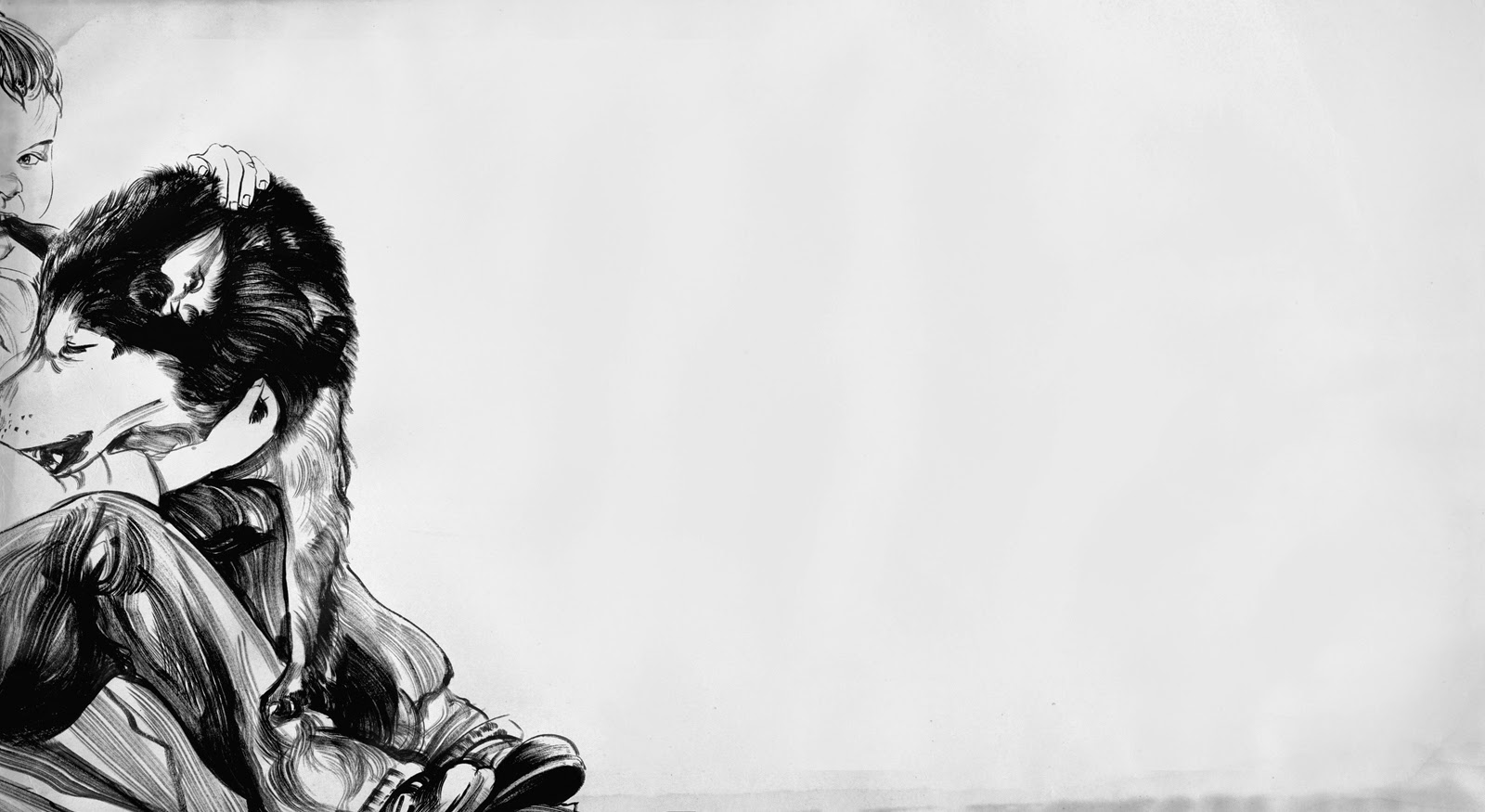 |
| from THE 52 WEEKS PROJECT: Year Two |
Now this is a tricky one. Yes most people see color pieces as final pieces and anything black and white as something on the way towards it’s color finale. Personally I think that’s bull-poop. I love black and white and make no bones about going out of my way to trumpet and celebrate it wherever I can wherever it deserves it. Black and White is raw and real to me in a way finished color isn’t. If you can deliver to me an emotional gut punch with a graphite drawing (see Kathe Kollwitz), then you have my vote.That isn’t to say others in my group feel the same, nor does it promise the same for future judges… but I can guarantee we all never dismiss a black and white piece that knocks our socks off. So don’t be afraid to buck the coloratti and bring on your tonal awesomeness. Color can often be a crutch to hide bad drawing or a lack of delivered emotion in the piece itself. Now don’t get me wrong… I would never negate a piece simply because it was all about its color (I’m looking at you Van Gogh). I’m just saying in a world of thousands of colorful pieces of art, the black and white jumps out from the pack. You fortify that quality with a delivered intent, and there’s no stopping you. Something that soars with such a limited toolset is something to truly admire. I saw a tremendous amount of black and white work over that weekend and I remember all of them that I picked and fought for. If I never judge another Spectrum again, I want to open each successive book from here forward and see more of them increasing in each passing year.
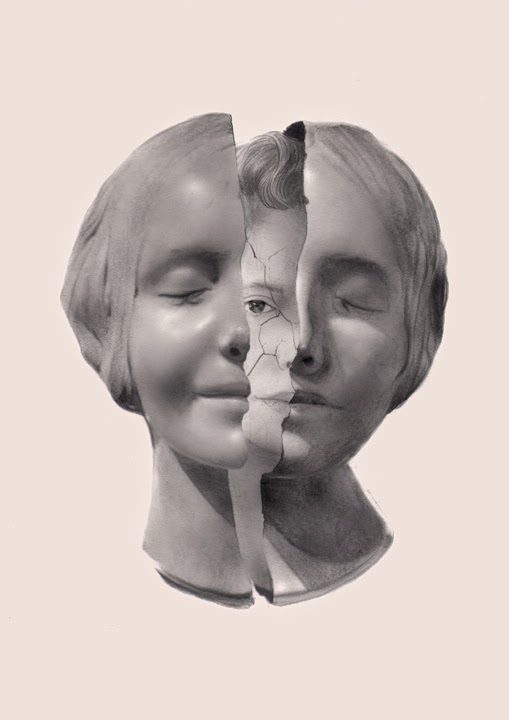 |
| Jane Eyre portrait. Graphite on paper. |
Again, Spectrum has an ethos and history to it that should be maintained and will be. It has no intention of abandoning its core audience or turning away from its decades-long history. But that doesn’t mean all the work has to ape that tradition, or by doing so make us forget other problems with the work simply because it accomplishes the fantasy taste-test. Their goal is to make each new issuance of Spectrum be of now and today, even whilst maintaining its past. So don’t ever feel you can’t submit something because it doesn’t necessarily fit in with some prescribed, or previously fortified idea of what “fantastic art” really is. And for the love of all that’s holy, don’t tack on a fairy to a portrait of say… Adolf Hitler just to check off the fantasy requisite box. You deserve better than to sublimate your art to someone else’s idea of what art should be. tradition is from where we should start rather than something we should service. Don’t be afraid to push off from it’s edge and get lost in the wide open space out there- interesting things can be found only there.
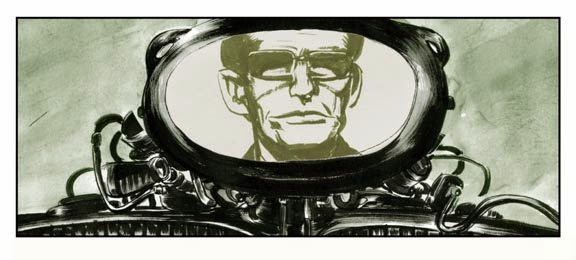 |
| Panel from the Neil Gaiman Matrix story, “Goliath”. |
This is super specific to Spectrum, as most juried things like this are all digital presentation now. But Spectrum has the beans, and the cups… And I simply LOVE th bit with the beans. So satisfying i can’t even tell you. This advice would also apply to any presentation you make anywhere. It’s not just the content you’re showing off when you present, it’s how seriously you take yourself in the manner and quality of that presentation. Physical work can ranger from 8×11″ printouts (my previous way) or large 16×20″ giclees. It’s a wild and wide world when dropping a bean on a piece, and while we really do ignore it all save for content, a torn piece or poorly printed art can sink you. We’re judging the work as it stands there, not how it could be. I don’t know how many pieces we looked at and someone knew the original and began to describe how much better it looked in person… and in the end as true as that may be, it doesn’t matter. Digital levels the playing field and it provides a luminosity to the work a printout just can’t deliver. Believe me when I say I weep a little in suggesting this because being able to get up from the computer station and walk around with the might Beans of Judgement in your hands is a true joy and relief to the eyes and back. I will be sorry to see the Bean Times pass into lore and legend, but having judged both the recent Society of Illustrators show and now Spectrum… I can tell you it will all be digital soon enough, and for all practical reasons, should be. (sorry bean friends!)
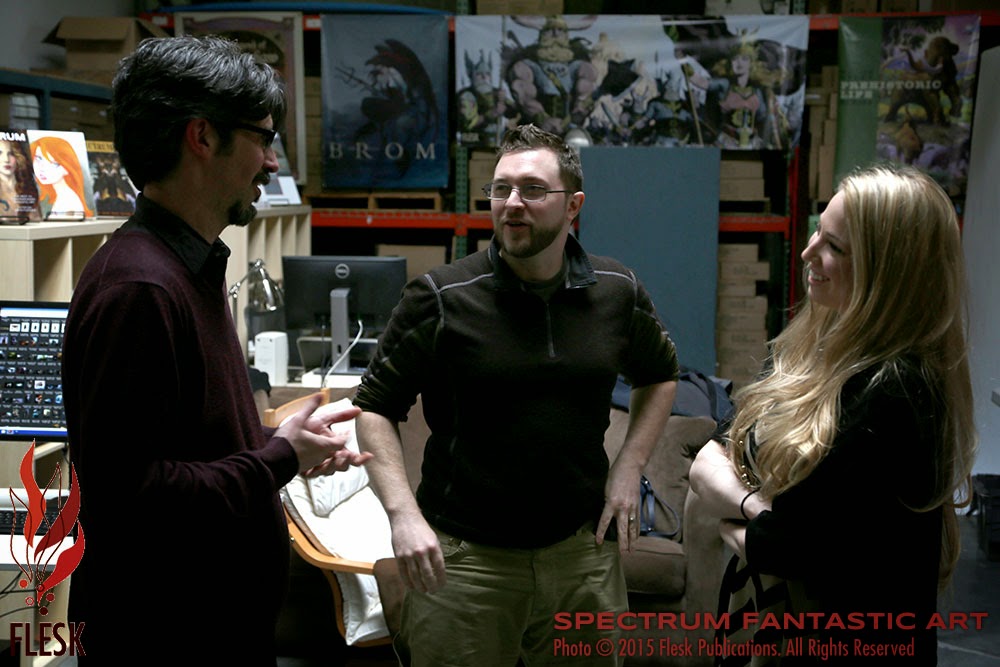 |
| Myself, Justin Gerard and Annie Stegg butting heads like rams on the mountain of Olympus. Well not quite apparently. |
The hard fact of it is that far more people will be excluded from the final collection that make it in. Most of you then, will be heartsunk when you can’t find your name on that call list. I haven’t always gotten in myself, and I can tell you for a natural fact that some giants of the illustration world didn’t always get their pieces in either. One of the hardest essentials of showing your art to others whether chasing a profession, or just fulfilling a dream to do so, is taking a loss with grace and wisdom. Just because you didn’t make it into Spectrum, doesn’t mean you’re not good enough or shouldn’t try again. Hell, I say it’s reason to do so. Same as well for the awards. Personally I think winning is being in the book alongside some of your friends, admired icons and up and coming future lunatics. And I would be happy to call it at the nomination phase too. But winning is fun and we all like seeing people win things. Take a loss and turn that into scar tissue for the next one that comes. Never hang your hat on the one thing when you should just keep tossing it front of you, further and further. You have as good a shot as any genius career goliath has, and that’s pretty amazing to think about when applying. Names don’t matter, nor career status or anything like that. It’s a totally flat field, and that is a rare event in art. You can’t win or lose if you don’t play and either outcome is always superior to not trying at all. Next year is always coming up fast, and I know I can’t wait to see what the next crop looks like.


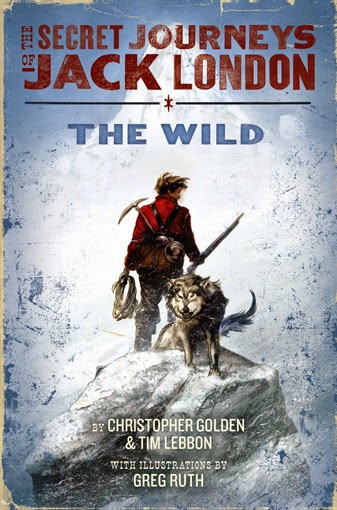
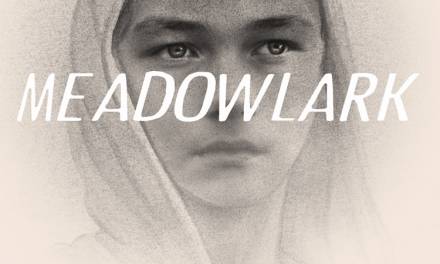
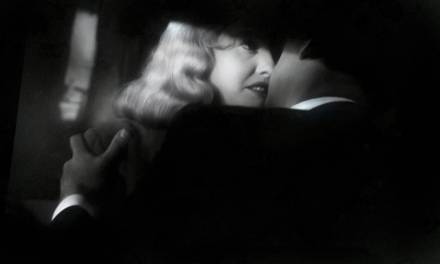

“Beans of Judgement”. Haha! This needs to be made into a button to give to the judges for next year. Or maybe the lifetime achievement award should be a bronzed bowl of beans. Yes, this is good.
Great read Greg. Looking forward to seeing this in print come fall.
Viva Frijoles Santos de Juicio!!!
Me too! It was such a dizzying amount of work I can barely remember half of what I voted for at this remove. We walked away all feeling really excited for the book and its representation, so that must be a good sign. I think if we go to digital, they should at least replace the on-screen start system with little bean images. You know… for kids!
As a former juror we will always have the beans in common. I even remember my color. Glad you had a great experience Greg. Working hard, enjoying colleagues and looking at art. Not a bad weekend I would say. Great points too!
Thanks for the insight Greg! I really enjoyed reading this post.
I second Howard on the “Bronzed bowl of Beans” Award. That would be awesomely fantastic.
It was really wonderful and I had so much fun. We sorted out our beans based on hair color I think. I got black beans, Virginie got Red Kidney, Annie some marbled tan and brown beans, and Justin got the light tan beans… I think just because that was left.
The beans are such a SPECTRUM institution… There has to be a way to honor the power of the mighty bean even when it all goes totally digital. Matrix Beans are fine, but the bean must be respected.
Thanks so much for this, Greg! Not getting in was a kick, yeah, but reading words like, “some giants of the illustration world didn't always get their pieces in” really takes that away. I'm reminded of all the companionship of the industry, and am still looking forward to go to SFAL for the first time this year. One day I'll be able to say I made it into the book with all my friends.
I'm certain you will indeed. And yes I can say as a witnessed fact a LOT did not make it through that on their own and in a vacuum would have won the day entirely. SOmetimes it's more about the context and that moment in time that brings down that axe, and I hope reading it as an encouragement to try again remains in place of the wrong way of seeing it- as a rejection. There's just only so much space to occupy and five different perspectives to contend with in choosing. A lot of good simply just gets lost in that, and that's just the laws of physics in the room. Not a bad or good thing… just a thing.
Great post Greg! And really well said. Annie and I feel like we had some of the best discussions on art we've ever had with you guys! We wish you could make it to Spectrum LIVE this year to see the awards ceremony!
Thanks Justin-I feel the exact same way. Total brain workout in the best of ways. It would have been dull as paint drying if we all shared the same point of view. I would love to go to Spectrum Live as well, but have to wrap up Indeh instead. So,eday soon i hope!
Thank you so much for the thoughtful insight Greg! This is so helpful, especially when the submission process is split between digital and print and so many more people are entering. Great advice for way beyond just getting into Spectrum, but making good honest work. I have Not got in waaay more than I have got in and I think not getting in for a stretch after having been included for consecutive years and even a full page years ago absolutely made me a better artist and pushed me to find more of my own voice. Plus being in touch with the community is so helpful. There are so many amazing artists that don't get in sometimes. Many who have NEVER got in (and their careers are doing just fine thankyouverymuch) so it's good to have perspective. Bonus high-five for the Black and White comment too! Black and white unite!
Thank you Greg, for this informative article! This article is very helpful to those like me that have tried several times to get into Spectrum but hasn't yet had the success. As a lifelong artist that has always done well with fine art but wants to break into fantasy illustration I thank you for writing this.
Thanks Kristina. When i was there looking at it all it became all so clear. I can't help but wonder how much we'd all benefit from seeing how the sausage gets made. And my oberal dislike of awards stems from it being mistaken as the goal, rather than encouragement for the artist on the way to their goal. Most never get in. I mean we must have selected three hundred pieces of work out of over five thousand, just to put it in perspective. I only bring that up over and over because it's a bit like self incriminating for not winning the powerball. The odds and the math are just not in anyone's favor. But a lot of folks get really angry when they don't get in as if they were somehow entitled to inclusion. Whichnis the exact opposite ethos behind Spectrum in the first place. Thanks for your comments, Kristina- big fan of your work.
I think we should make a flag for the black and white power. Maybe a charcoal fix punching a rainbow in the face?
Happy to help in anyway. I think one of the things I try and hope to do is demystify all this stuff, and make it seems more possible and less daunting. Glad you liked it.
Greg- Thank you! You just made my day in so many ways. And yes, for the love that all that is beautiful and monochrome, let's please make that flag happen! I will proudly wave it at my Spectrum Live table.